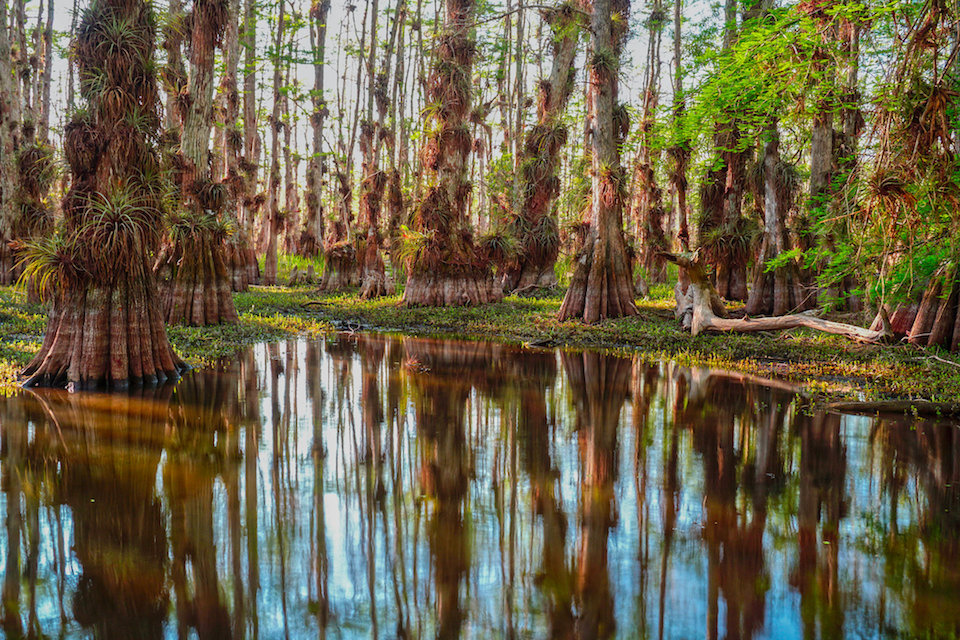Climate Impacts on Florida's Freshwater Ecosystems

Impacts of Sea Level Rise:
- Loss of freshwater coastal dune lakes as salt water encroaches into system
- Loss of coastal freshwater marshes – conversion to brackish/salt marsh
- Reduction/loss of critical freshwater sources in the Keys
Impacts of Salinity Shifts:
- Decrease in salt-intolerant vegetation due to increased salinity
- Decrease in coastal and tidal freshwater marshes due to changes in community structure as salinity increases
- Loss of critical freshwater sources in the Keys due to salt water intrusion
- Decreased productivity/growth of vegetation (wild celery)
- Reduction in groundwater due to changes in location/amount of withdrawals for drinking water as salinity increases at some locations
- Loss of suitable habitat for those species with limited osmoregulation
Impacts of Warmer Summer Temperatures:
- Reduction or loss of wetland habitats due to increased evaporation rates
- Higher eutrophication rates
- Reduction of submerged aquatic vegetation
- Increased growth rates of aquatic vegetation
- Increase in invasive species that can tolerate higher temperatures and low oxygen
- Increased algal blooms
- Less dissolved oxygen in the system
Impacts of Warmer Winter Temperatures:
- Northward range shift of aquatic exotic species
- Increased growth rate and expansion of invasive plant species
Impacts of Increased Extreme Heat Events:
- Reduction or loss of wetland habitats due to increased evaporation rates
- Higher eutrophication rates
- Increase in invasive species that can tolerate higher temperatures and low oxygen
- Increased algal blooms
- Less dissolved oxygen in the system
- Northward range shift of aquatic exotic species
- Increased growth rate and expansion of invasive plant species
Impacts of Increased Extreme Cold Events:
- Increased mortality for cold temperature sensitive species
- Increased occurrence and severity of cold kill events
- Limit northern extent of exotic species range (potentially beneficial change)
Impacts of Increased Precipitation:
- Increased nutrient and sediment loading due to increased runoff
- Reduction in availability/connectivity of spawning areas
Impacts of Decreased Precipitation:
- Reduced average freshwater discharge from Lake Okeechobee
- Reduced littoral zone flushing of tussock and other organic material
- Reduced spawning habitat as connectivity between rivers and floodplain is reduced
- Increased abundance, prevalence and diversity of aquatic parasites
- Increased cyanobacteria blooms and cyanotoxin concentrations in waterbodies
- Decreased connectivity of 1st and 2nd order streams to main channel
- Reduced river stage and flows in panhandle affecting freshwater mussel beds
- Loss of herbaceous aquatic vegetation as hardwood and pine encroaches into wetlands
- Lake bottom drying allows for burning of land bed stimulates desirable aquatic plants (potentially beneficial change)
Impacts of Changes in Timing of Precipitation:
- Altered water chemistry
- Altered low level trophic interactions – temporal mismatch between phytoplankton and zooplankton
- Reduced connectivity during breeding season
Impacts of Changes in Frequency and Severity of Extreme Events:
- Altered habitat type/composition of wetland communities due to wind damage
- Increased erosion, sediment transport and runoff into freshwater systems
- Increased spread of exotic or invasive species
- Increased levels of particulate and dissolved substances (nitrates, ammonia)
- Altered water chemistry due to increased runoff
- Increased mortality due to increased pollution entering the aquatic systems
- Increased stream flow
- Increased high water levels due to increased precipitation from storms
- Altered water quality due to changes in nutrient and sediment
- Increased extent of freshwater habitats due to increased precipitation from storms (potentially beneficial change)
Impacts from Increased Floods:
- Increased connectivity of ephemeral wetlands to adjacent wetlands and water bodies
- Increased woody debris carried in stream channels
- Increased flow of pollutants from surrounding watersheds into streams, rivers, ponds and lakes
- Displacement of stored organic carbon as floods cause scouring of the streambed
- Increased turbidity and sedimentation from runoff
Impacts from Increased Droughts:
- Changes in stream temperature
- Changes in debris loads due to alterations in riparian vegetation
- Decreases in the oxygen-holding capacity of surface water
- Increased anoxia and chemical transformation in surface waters
- Alterations in the transport of organic matter or sediments into freshwater systems
- Increased heavy metals and other toxic substance concentrations Decreased bacterial, fungal and microbial activity due to reduced detritus decomposition
- Increased protozoa and bacteria levels in warm water
- Increased habitat fragmentation due to changes in spatial distribution and extent of habitat
- Increased invasive nonnative plant species in lakes and wetlands
- Reduced spring flow
- Increased mortality of riparian trees and other vegetation
- Loss of connectivity between freshwater systems
- Decreased stream flow or drying up of streams in areas downstream of springs
Impacts of Altered Water Chemistry:
- Increased invasive plant growth for those species that have an affinity for CO2 (e.g., hydrilla)
- Increased damage to host plants by epiphytes due to increased epiphytic growth
- Increased harmful algal blooms due to high nutrient inputs
- Altered community composition – loss of more sensitive species
- Reduced fitness for shell producing species
- Altered growth rates
- Increased eutrophication
What's next?
Learn about climate-related impacts to marine and estuarine ecosystems in Florida.